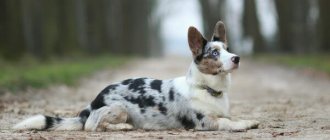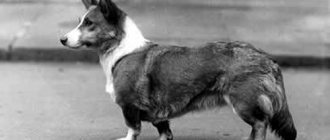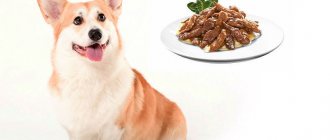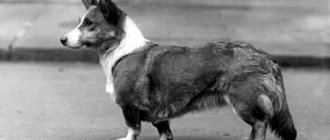Often, future owners choose a Corgi puppy based on its color. At this stage, difficulty arises, since this breed has a multifaceted palette of coat colors and one cannot do without a hint.
There are two varieties of this breed: Pembroke and Cardigan, and this also complicates the task of choosing. Who do you like best? The small Pembroke Corgi, which looks like a fox and is always smiling, or the Cardigan Corgi, which has a serious expression on its face and a large body structure.
An article from which you can learn and analyze the possible nuances of standard Corgi colors will help you with your choice and get rid of future disappointments.
Standard Pembroke and Cardigan
According to the generally accepted world standard, the color of the Pembroke Welsh Corgi can have many basic shades of red, brick red, red wheaten, as well as elegant sable and fawn colors or classic black with white markings.
According to the standard, the Cardigan Corgi has more colors than its small brother Pembroke. The cardigan can have any color allowed for the Pembroke, as well as rare coat colors: brindle, harlequin and blue merle.
The most popular coat colors for the Corgi breed are red and white and tri-color, where white should never be the main color.
The red-white coat color ranges from pale red to bright red. The coat has reddish shades with snow-white spots.
Corgis with a tri-color color are black, red and white. The black shade is located throughout the body with reddish markings and white.
Incredibly, the color of a dog's fur affects its character in the future.
Despite the huge variation in colors, Beagles are allowed to have a certain number of colors. These include black, white, red, brown and all their shades. The arrangement of tones is not regulated by canine associations. Read here: Beagle colors.
The Pembroke Corgi cannot be brindle, blue merle or merle.
Small puppies can be two-colored, but with age their colors can change to tricolor, but for this both parents must be tricolored.
Unacceptable color options for Welsh Corgis
Since corgis have many shades of color, animals are often born with color defects that do not fall under the generally accepted breed standard.
What is considered a breed defect?
A black corgi cannot have a brindle shade according to the standard, since only gray shades of stripes are allowed in its fur. If a brindle corgi has a charcoal color, this is considered a defect in the breed and such animals will not be allowed to exhibit.
A completely white pet is also considered a defect; moreover, according to the standard, white color should in no case prevail over other shades, especially among tricolor Welsh Corgis. In the black and white variety, a defect is considered to be the presence of white hairs on black wool and black hairs on white.
Note! There is no need to worry about the presence of a defect. This does not mean that the dog is sick, because animals preparing for exhibitions must meet the breed standard.
Corgi dogs, whose colors have a huge variety, can become faithful companions and good-natured merry fellows. In addition to the usual two-color and three-color coats, these pets also have rare brindle, sable and merle colors, so owners have many options to consider when purchasing a puppy.
Tricolor
Tricolor - this means that the dog’s coat has 3 colors, where one is the main color, and the other 2 colors will play the role of secondary ones. The tricolor color is divided into:
Blackhead
These dogs are almost black in color.
Black color is very insidious. It can simultaneously emphasize both the beauty of the dog’s exterior and reveal the dog’s external flaws.
And thanks to black, the dog looks slimmer, more elegant and appears smaller in size.
You might be interested
Deep coloring
In this case, the coat has a bright reddish tint, deep black on the body and white on the chest, neck and muzzle area. Moreover, all three colors have uniform application.
A dog with a deep tricolor coat color looks amazing. In this case, the head is reddish, and dark spots are possible near the ears.
Redhead
With this coloring, the dog is almost all red. There is little black color (in this case) and only on the back. A common occurrence with a red-headed tricolor is pale yellow fur on the tummy, as well as in the chest area and on the “pants.”
Ginger
The red color of the coat is the most recognizable color for the Corgi breed. In this case, the red color can be the most diverse, ranging from pale red to bright red, and in addition a black “mask” on the muzzle is allowed. It is the black “mask” that makes the dog expressive and gives it seriousness.
Your puppy will have a black “mask” only if his parent has the same “mask”. The snow-white color in the red Corgi is usually present in the limbs, groin and face.
Sable
The true sable color of the coat looks amazing and gives the impression that the dog is glowing. Unfortunately, true sable color is a rare occurrence. The essence of sable wool is that at the base the hair has one color, and its tips are always a different color.
Usually the base of the guard hair is light or even red, red, sandy, and the tip of the hair is a more saturated dark, almost black color.
The sable color can appear in a Corgi puppy after 3 months and it starts from the head or in the chest area.
Deer
Deer color is one of the most ancient. Deer includes all shades of sand and golden tones, from the lightest to the deepest colors. However, in this case there should not be a manifestation of a palette of red tones.
A distinctive feature for deer colors will be the transition from dark to light tones on the hips, under the tail, on the limbs and on the belly of the dog.
You cannot call a deer's fur color fawn, sand or red, since these colors are a completely different phenomenon.
Cheprachny
Black-colored wool is conventionally classified as tricolor. These puppies are born almost gray rather than red, and then the gray tone goes away. The Corgi's similar color makes them look like real shepherds. The only difference is that the Corgi will have white markings on the chest area and on the front and back legs.
The saddle coat is a combination of the color palette of the main red and dark grayish or black “saddle blanket”, which covers the dog’s back like a blanket. In this variant, black hairs (starting from the base of the head) extend to the bridge of the nose, forehead, ears, shoulders and tail.
Story
The Welsh Corgi Cardigan breed appeared in the British Isles (the territory of Cardiganshire, which is now called Ceredigion and is an administrative unit of Wales).
Initially, miniature shepherd dogs were used as herding dogs, becoming widespread in this capacity since the 10th century. They began to participate in exhibitions in 1892.
Officially, the Cardigan breed standard was developed in 1934, when the differences with Pembrokes, which are also Welsh Corgis, were finally established.
Two-color
A two-color black and white coat palette is not uncommon for Corgis.
Black and white
In this version, the dog will be black in body with pure white markings in the muzzle, collar area, chest, at the withers, limbs and tip of the tail. Moreover, there should be no white hairs on a black background, and the presence of black hairs on a white background is not allowed.
brindle
The name brindle speaks for itself. This color has a transverse striped pattern. Transverse dark stripes are located on wool with a yellow, brown, fawn, or earthen background.
The most beautiful and correct brindle is represented by a light brown and golden main background of the coat, decorated with intense dark stripes (half rings), which disappear in the groin area and connect on the back.
In this case, there is often a black mask on the Corgi's face, and the presence of pure white spots does not serve as a flaw.
Brindle color is allowed for the Cardigan Welsh Corgi, but the Pembroke Corgi does not have it.
Marble or Blue Merle
Marble coloring or blue merle is a miracle of nature and a real fantasy. In this variant, the main coat of the Corgi is white-gray, white, gray with blue tones. The secondary tone of the spotting should be much darker.
Small marks resembling small dots, blots or stripes are scattered in a chaotic manner throughout the dog’s body. Interestingly, the Blue Merle palette also allows for white spots on the body. The peculiarity of these colors is that the main part of the guard hair is light, and the tip is dark.
Funny video
Watch a funny video in which you will see a wonderful representative of the Blue Merle Cardigan Welsh Corgi.
General characteristics of the Cardigan Welsh Corgi
Despite its short stature, the Cardigan Welsh Corgi is still a shepherd dog. These dogs are active, energetic, love to accompany their owner everywhere, and are capable of performing various tricks. They are efficient, hardy, unpretentious. From their herding past, they inherited the instinct to herd everyone, so they can bite people on the legs.
This Welsh Corgi, or simply Cardigan, is a very sociable dog. He becomes attached to his owners and is very bored alone. Does not show aggression towards strangers. And because of his curiosity and good nature, he will try to make friends with everyone. These pets get along well with children and other pets. Many dog breeders believe that this is one of the smartest and most charming dogs.
| Options | Characteristics |
| breed name | Welsh corgi cardigan (Welsh corgi cardigan) |
| place of origin | UK, Wales, Cardiganshire |
| group of breeds according to the ICF classification | herding dogs, cattle dogs, shepherd dogs |
| application | shepherd, hunter, companion, service dog |
| height | males 27-31 cm, females 15-30 cm |
| weight | males 14-16 kg, females 12-15 kg |
| life expectancy | 12-15 years |
| coat type | wirehaired |
| character traits | smart, good-natured, inquisitive, non-conflict, loyal, sociable, energetic |
| attitude towards people | not aggressive, friendly, does not tolerate loneliness well |
| activity | tall, energetic and resilient |
| intelligence | very smart |
| training | light |
| difficulty of care | easy, although they shed a lot |
| health | average |
pros
The Cardigan Welsh Corgi is a kind and peaceful dog that is suitable as a companion even for inexperienced dog owners. The breed did not immediately become popular, but now many have fallen in love with these cute, funny, short-legged shepherd dogs. They have many advantages:
- its small size allows you to keep a Welsh Corgi in an apartment;
- the dog is unpretentious, easily adapts to any conditions;
- this is a wonderful companion, watchdog;
- devoted, faithful, attached to the owner, very sociable;
- unobtrusive, senses a person’s mood;
- smart, quick-witted, easy to train, suitable for inexperienced owners;
- balanced, non-aggressive, good-natured character;
- these dogs are hardy and efficient;
- playful, funny, love to perform different tricks;
- They are easy to care for.
Minuses
But the Cardigan Corgi is not an ideal pet. Representatives of the breed have several disadvantages:
- during molting they lose a lot of fur;
- loneliness is very difficult to bear;
- poor health, many hereditary diseases, prone to obesity;
- very active, requires a lot of physical activity;
- due to herding instinct, they can bite the legs;
- bark loudly;
- prone to stubbornness.
The video talks about the pros and cons of the Cardigan Welsh Corgi:
Video: Welsh Corgi Cardigan - All about the dog breed
Video: Welsh Corgi Cardigan
Comparison of Pembroke and Cardigan Welsh Corgis
Corgis are herding dogs bred in Great Britain. This name comes from the combination “dwarf dog”. Indeed, these shepherd dogs have short legs, thanks to which they easily moved through a herd of sheep or cows and grabbed their legs.
The Corgi breed has two varieties. Despite the similarity in territory of origin and appearance, they are different. Therefore, in the 30s of the 20th century, these branches were separated into separate breeds: Cardigan and Pembroke. The difference between them is barely noticeable, but still there.
- Cardigan corgis appeared earlier, known since the 10th century. After the appearance of the Pembrokes in the 13th century, they gradually began to displace their relatives. Until now, this branch of the breed is more popular throughout the world.
- The main difference is in appearance: Cardigans have longer legs, they are larger, tougher and more maneuverable than Pembrokes. They have a longer tail and more varieties of colors: merle or blue merle, brindle.
- There are also differences in the character of representatives of the breeds. Cardigans are calmer, more reserved and reasonable. Pembroke is more lively, active, playful.
An interesting video will complement the description of Cardigan Welsh Corgis and their differences from Pembrokes:
Video: 5 differences between the Pembroke Welsh Corgi and the Cardigan Welsh Corgi
Compare with colors of other dog breeds
- Beagle
- Basenji
- Miniature Schnauzer
- Sheltie
Despite the huge variation in colors, Beagles are allowed to have a certain number of colors.
These include black, white, red, brown and all their shades. The arrangement of tones is not regulated by canine associations. Read here: Beagle colors. The Basenji is an ancient indigenous dog breed. Its development took place without human participation, for this reason their colors are very diverse. White shades in certain areas of the Basenji's body are mandatory. Read the article: Basenji colors.
In the standard, only absolutely black (the undercoat must also be this color), pepper and salt, black and silver and white with a snow-white undercoat are acceptable. More details here: Miniature Schnauzer colors.
This breed has four main colors, but their shades are varied and rich. In all varieties (and for black it is mandatory) white spots are allowed on the forehead, collar area, chest, tips of the paws, and tail. Read the article: Sheltie colors.
Types and colors of corgi
The British breed is divided into two varieties:
- Welsh Corgi Pembroke;
- Welsh Corgi Cardigan.
The colors of the Pembroke Welsh Corgi differ from the standards allowed for Cardigans.
Experts believe that the original coat color was black and brown. There is no single color. The most common dogs are red or tri-colored.
Price of a Pembroke Welsh Corgi dog
The average cost of a puppy in the capital and large cities, as a rule, varies in the range of 45-65 thousand rubles.
When choosing an animal, you can also focus on the following average price data:
- representatives of the pet class - 20-25 thousand rubles.
- representatives of the breed class - 30-40 thousand rubles.
- representatives of show class - 45-60 thousand rubles.
It is very important to provide your four-legged pet with the earliest possible socialization, as well as purchase all accessories in advance and allocate a permanent place.
Sources:
https://dogipedia.ru/velsh-korgi/
https://simple-fauna.ru/pets/dogs/breed-of-dog/velsh-korgi-pembrok/
https://4lapki.com/2017/03/kak-uhazhivat-za-sobakami-porodyi-korgi#i-5











